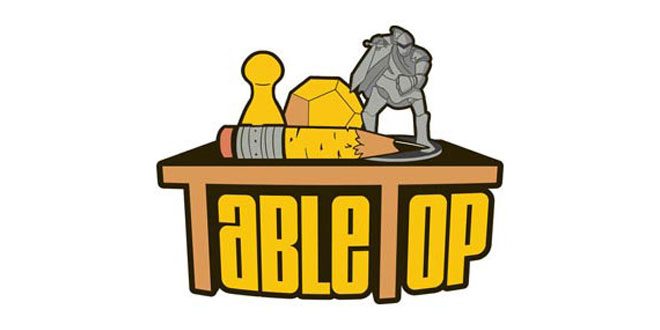Last week GeekDad’s James Floyd Kelly posted about playing skirmish games with your kids. He beat me out of the blocks, as I had already been planning this post about playing Warhammer Underworlds: Shadespire with your children. In his post, James mentions Shadespire, and he’s right; it’s a great game to introduce to your kids.
If you’re not familiar with the game, click here for my various articles on how to enjoy playing Warhammer Underworlds: Shadespire. You can also find out why I consider it worthy to be GeekDad Approved.
Arguably, there hasn’t yet been a better time to introduce newcomers to this fledgling tournament game. This weekend sees the release of two new warbands, the Skaven and the Dwarfs (Fyreslayers), increasing the number of playable warbands by another 50% to 6. These new warbands and the cards that come with them open up new tactical possibilities, with variations that look set to blow the current best-perceived ways to play out of the water. But tactical talk is best left for another post. If you do want to keep up with all my latest thoughts on the game and the best ways to play, as well as full matches, do check out my YouTube channel, Agents of Sigmar.
If you are interested in playing the game and wondering if it’s family friendly, here are my 10 reasons to play Warhammer Underworlds: Shadespire with your children.
1. You can play it straight out of the box.
The box costs $60 (or $51 on Amazon.com. £40 in the UK, cheaper if you shop around). It has everything you need to play a game. Miniatures are provided to play with two different warbands. They clip together without glue. (In theory anyway; a little polystyrene cement may be needed.)
The box has enough cards to make decks for both warbands, plus extras to add some tactical variation and nuance. Your decks won’t be as competitive as somebody who has access to all the cards (and this situation is likely only to get worse as more cards are released), but if you’re playing in the home environment, you have what you need for many great games. Caveat: one of the warbands, Khorne, has the motto of “Blood for the Blood God” and one of the models carries a severed head. Whilst not overtly horrific, this warband may not suit children of a more sensitive disposition.
2. The game is quick.
Certainly by Games Workshop standards. Full games of Warhammer or Warhammer 40,000 take hours. Warhammer Underworlds games take 30-45 minutes, which is probably the average set up time for GW’s tabletop wargames. This makes it great for smaller attention spans.

3. Its small model count.
The small model count makes for an excellent introduction to the artistic side of the hobby. The highest number of models that it’s required to paint is seven (only 3 and 5 for the warbands included in the base set). An achievable target, unlike a tabletop wargame, where you’re looking at something in the region of at least 30 models before you have anything resembling a full army. The small model count won’t overwhelm younger players, making Shadespire a brilliant way to inspire them to paint.
Note: it isn’t even necessary to paint the models, even for tournament games. Something of a departure for GW. All they ask is that the models are distinguishable as your own.
4. No blind boosters.
This is not a collectible card game. There are no rares to hunt for, no duplicate artworks that you “need” to collect. You won’t be spending money looking for an elusive card, only to see the new packets discarded because they don’t contain it. And, because in Warhammer Underworlds decks may only contain one card of each type, you don’t need to purchase the same thing multiple times to build up a stack of a particularly potent card. This is not a pay to win situation, where the person who can afford the most cards is going to have the best cards.
Caveat: if you don’t buy all of the boxed warbands, you won’t have all the cards at your disposal, putting you at a slight disadvantage. This doesn’t particularly matter for playing at home, but may end up being so if your child wants to play competitively. If, within your family, you have two players who want to play the same card, most of them aren’t duplicated. This potentially means for two, strictly legal, decks, you may find yourself needing to buy two boxes that are the same. A bit of negotiation (or color printing) can work around this problem.
All the current cards can be found here.
5. It’s a social game.
It’s easy for a few friends to get together and play a few games. The short game time means Shadespire can easily fit in as an after-school activity or a few games before bed on a school night. You can switch between opponents quickly or even play full four-player games, if you have two sets. The game is very portable for a GW game, too, making it easy to take along to a club night or even start your own lunchtime club at school. Like many board games, it teaches sportsmanship, winning and losing graciously, and a bit of give and take by giving your opponents some leeway in taking back their mistakes.

Reasons 6-10 outline the strategic skills that playing Warhammer Underworlds: Shadespire might bring.
6. It teaches forward planning.
Shadespire is all about planning. From the outset, you have to decide which objectives you’re going to include in your deck. Then you have to build your power deck to help you achieve your chosen objectives. Your entire game strategy will be built around the plans made before your games start. After that, you have to think about board placement and warband placement when setting up, all with the intention of fulfilling your objectives. Much more than many games I’ve played, Shadespire is about creating a plan and executing it.
7. It teaches that not everything goes according to plan.
Of course, the moment your warband hits the tabletop and starts interacting with the enemy, your plans usually start to go wrong. One of the most important parts of the game is adapting your plan whilst keeping in mind what you want to achieve and using the resources you have in your hand to make it so. Being adaptable when things don’t go your way is a hugely important life skill and one that is transferable from playing Shadespire.
8. It helps improve memory.
You have two decks, one of 12 cards and one of at least 20. Remembering what you put in them is vitally important if you want to win games of Shadespire. Not only that, if you play best-of-three matches, remembering what your opponent has in their decks helps you plan for what’s coming, making it easier to defeat them.
9. It teaches probability.
There are two sets of probabilities to learn about in Warhammer Underworlds: card and dice probabilities. This can be as simple as the chances of drawing a particular a card from your objective deck (1/12) or rolling a critical to defend an attack (1/6), or can lead you to learn about more complex probabilities from rolling multiple numbers of the game’s custom dice or learning about hypergeometric distributions for card drawing.
10. It teaches tenacity.
One of my favorite things about Shadespire is that it isn’t over until the very end. Even when all can seem lost, there is a chance to sneak a victory (or at least a less crushing defeat). Not giving up is an important life skill, and whilst a game of Shadespire is hardly a character-defining moment, the understanding that things can and do get better may be helpful when more serious real-world setbacks arise.
Those are my 10 reasons for enjoying Warhammer Underworlds: Shadespire. Do you agree? Are there any other reasons to play this game or any other board game? What other skills can Shadespire teach? Let us know what you think in the comments below!






What are your thoughts about this game compared to X-Wing Miniatures? After all, X-Wing is a more familiar property and can be completed in the same amount of time.
Great question! Whilst X-Wing is immediately more appealing, I think Shadespire is the more forgiving game. The precise positioning required in X-Wing made it a frustrating game for our family. If the table gets banged and the ships fall over, outrage ensues. For Shadespire, not only are the models more stable, orientation doesn’t actually matter.
I also think Shadespire provides are more varied experience in game, with new cards entering play every time. My kids often get bored of X-Wing before the end.
Shadespire also takes up slightly less room and comes with its own playing surface.
Hope that helps!
Thanks for the response! Your points in favor of Shadespire make sense. My kids are not quite old enough to play these games, so I definitely have some time to chew on this before trying to introduce this style of game to them.
What is your opinion of your pay-to-win now that expansions seem to be announced every month and there’s talk about card only expansions? Seems to be moving fast toward the pay-to-win model for anywhere besides playing at home. At my local store all the players are buying every expansion to build the best decks even for store play.
Hmm, that’s a difficult one. I do still love the game, but I agree the need to buy all the sets to remain ultra-competitive is a worrying trend. On the one hand, I feel it’s never too bad, because you can only include one of each card, and card count is fairly low. On the other, if the “meta” keeps evolving so that you have to buy new cards, that’s unfortunate.
But, I guess that’s the model for all these types of game. There is always something to keep you buying. I still think Shadespire represents reasonable value for money, especially if your club or group implements some house rules. We’ve recently been playing with “Faction Fraction” rule where a % of you cards must come from the faction you a playing (We went for 33% of Objective Cards and 50% of Power Cards). This is a great leveller and allows some different tactics from the typical deck builds.
Of course, if you’re not playing seriously, and the people you’re playing with don’t mind, you could always proxy some cards. That’s no good for (official) tournaments, but my guess is, if you’re a tournament player, you’re “all in” anyway.